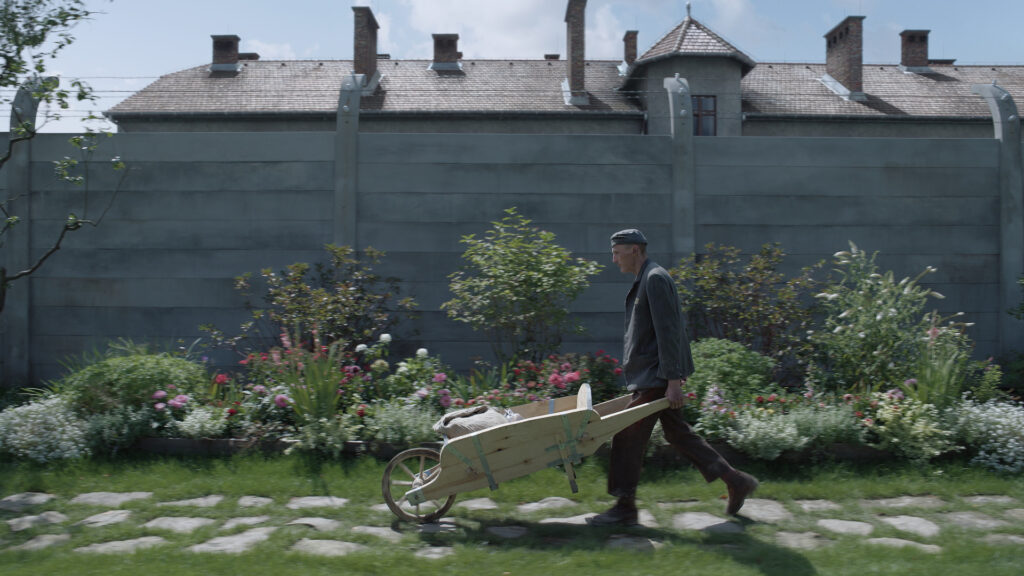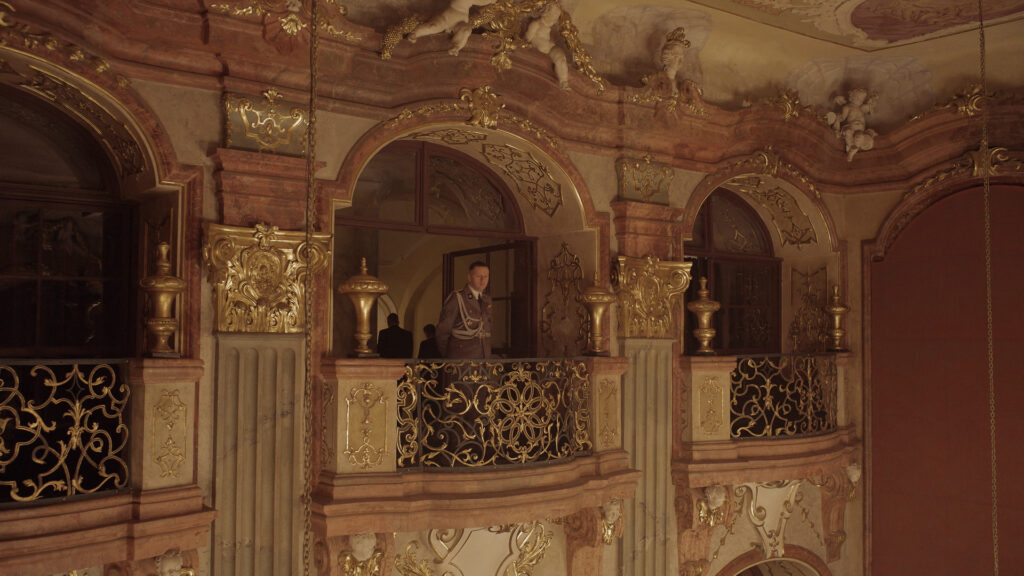Jonathan Glazer’s first feature in 10 years is a near-unclassifiable work of patience and intentional distance from its historical horrors.
What am I to say here? What can I say?
I feel as if I’m to say nothing at all. My mind has gone and I feel sick, and while that’s due to the film in question, another degree of it comes from a deeper truth. I feel wrong in my reaction to it; it can’t help but feel inadequate. The Zone of Interest has leveled me like few things ever have, but that’s not the point. That’s not its point.
And yet, I can’t help but focus on what it’s doing to me.
The Zone of Interest is Jonathan Glazer’s first feature in a decade. Like Under the Skin, it’s a loose adaptation, this time of Martin Amis’ 2014 novel. Its sights lie on Auschwitz Commandant Rudolf Höss (Christian Friedel) as he lives directly over the wall from the concentration camp. He and his wife, Hedwig (Sandra Hüller), live in an affluent home with their children, he works to dispose of prisoners’ bodies and she on her prized garden. The cobblestone pathways and the house’s ribbed exteriors catch all light and engulf all shadows. It’s all very bright, and their personal and domestic goals are, in a word, unremarkable.
While its approach to the Hösses’ life borders on anesthetized, Glazer and cinematographer Łukasz Żal opt for a modern, crisp look almost unstuck in time. Combined with their predilection for static shots and Paul Watts’ editing, the pacing stays propulsive, a tone matched by the actors’ naturalism. (As it turns out, Glazer and Żal installed several cameras on set to avoid theatricality, similar to the hidden-camera approach of Under the Skin.) Performance is not a word that necessarily comes to mind here.

So how are we to process this? Not by seeing, perhaps. Glazer and company make something clear: we’re not to rely on our eyes. We’re not even to use our ears so much as our bodies to digest what unfolds. The film begins with a three-minute overture courtesy of Mica Levi, whose score swings toward the eschatological. With its melting choirs and droning bass, their music is not the kind we hear. It’s the kind we sense.
While monumental in its compositions, it only features a handful of times and is even more effective thanks to how sparsely the film uses it. Johnnie Burn’s sound design grants the residence an ambiance, the sounds of Auschwitz constantly floating through the house. The family barely registers the din—or perhaps they don’t anymore. It’s literally natural to them.
But with The Zone of Interest, Glazer has a deep preoccupation with nature in two main senses. The first is that of the family’s reactions. Take a moment early on in which Hedwig picks through clothes stolen from Jewish prisoners. We see her model a fur coat in the mirror to herself, physically invading another’s source of protection in an act the film links to the genocide outside. Elsewhere, one son toys with spare teeth. The Hösses are reactionary on a moment-to-moment basis, but they’re never passive. They’re worse. They’re detached, their curiosity colored by ambivalence.
All the while, there’s no onscreen physical violence here but the sounds of the atrocities. From overture to end credits, the movie uses its central dichotomy instead, establishing an unspoken—and largely unseen—language. Burn’s sound work is seismic here, and with it, the sound goes against sight, mental against physical, suffering against apathy. This is often a picture of visual beauty as well but said beauty is too amoral to function as such. Glazer is a filmmaker of semiotics; The Zone of Interest is fixated not just on spaces, but how they come to inherit the people around them.

This relates to a second sense of nature, which stems from the use of land. Through Chris Oddy’s production design, the Hösses’ home forms a nexus between cruelty and suffering. A road to town exists by its front, the camp in the back. A garden wraps by it to one side; past the other, a river stretches from the camp’s smokestacks past the property. While the perpetrators are at home in a pocket of the natural world, the victims are relegated to the industrial. Perhaps therein lies one of The Zone of Interest’s most difficult suggestions: that evil is itself natural.
In a traditional sense, there isn’t a lot that happens in Glazer’s piece, but that’s because everything that unfolds is bigger than its characters. The lasting impact is bigger than us, and it’s bigger than the Hosses’ awful, implacable mediocrity. Their idea of ordinary life grows. It rots, and at key times, the nature they cultivate begins to as well. Seasons turn. Glazer’s camera falls into labyrinthian interiors, buried deeper inward, farther from natural, perhaps closer to realization. A sickness blossoms.
There’s an idea of bodily purging throughout The Zone of Interest that I can’t help but come back to. Early on while wading in the river, the family realizes the prisoners’ ashes have filled the water, leading them to bathe while in hysterics. Later on, Rudolf sees a doctor who asks about his digestion. It’s as unsensational as the rest of the film is, but with all this, Glazer remains attentive to the human body. It will wilt regardless of who holds it. The film takes that unifying connection, no matter how tenuous, and turns it into the biggest horror imaginable.
It’s a masterwork of craft and silent, deafening devastation, a visual medium unchained from the power of its own sights.
I won’t say what the final five minutes entail, but suffice it to mention that it cements The Zone of Interest as achieving the impossible. It reaches insurmountable gravity without anything I could refer to as insincere or unnecessary. It’s a masterwork of craft and silent, deafening devastation, a visual medium unchained from the power of its sights.
How, then, am I supposed to describe my reaction to it? To discuss one’s response to art is a solipsistic admission in and of itself. It’s impossible to react objectively to art, but with The Zone of Interest, I feel that would be the only thing that feels right—feels unnatural. I know only the spectacle I feel upon bearing witness to its awful truth because, by its end, it’s impossible to define. It requires something I’m unable to give it logically, with the full respect it deserves. So, what am I to do here? What can I do?
The Zone of Interest opens in limited release this Friday, December 15 with a further expansion to come.
The Zone of Interest Trailer:
Read next: The Spool's Best New Releases
Streaming guides
The Best Live TV Streaming Services With Free Trial
The praises of live TV streaming services don’t need to be further sung. By now, we all know that compared to clunky, commitment-heavy cable, live TV is cheaper and much easier to manage. But just in case you’re still on the fence about jumping over to the other side, or if you’re just unhappy with ... The Best Live TV Streaming Services With Free Trial
How to Watch Power Book III: Raising Kanan Season 3
Season 3 of the hotly anticipated Power spin-off, Power Book III: Raising Kanan, is arriving on Starz soon, so you know what that means: it’s the ’90s again in The Southside, and we’re back with the Thomas family as they navigate the ins and outs of the criminal underworld they’re helping build. Mekai Curtis is ... How to Watch Power Book III: Raising Kanan Season 3
How to Watch Doctor Who: 60th Anniversary Specials
Ladies and gentlemen, we’re so back! To celebrate Doctor Who’s 60th anniversary, the BBC is producing a three-episode special starring none other than the Tenth/Fourteenth Doctor himself, David Tennant. And to the supreme delight of fans (that would be me, dear reader), the Doctor will be joined by old-time companion Donna Noble (Catherine Tate) and ... How to Watch Doctor Who: 60th Anniversary Specials
Which Netflix Country has Interstellar?
Maybe you’ve just seen Oppenheimer and have the strongest urge to marathon—or more fun yet, rank!—all of Christopher Nolan’s films. Or maybe you’re one of the few who haven’t seen Interstellar yet. If you are, then you should change that immediately; the dystopian epic is one of Nolan’s best, and with that incredible twist in ... Which Netflix Country has Interstellar?
Which Netflix Country Has Each Movie of The Hunger Games?
For whatever reason, The Hunger Games series isn’t available in the same countries around the world. You’ll find the first and second (aka the best) installments in Hong Kong, for instance, but not the third and fourth. It’s a frustrating dilemma, especially if you don’t even have a single entry in your region, which is ... Which Netflix Country Has Each Movie of The Hunger Games?
How to Watch ESPN With A Free Trial
One of the major concerns people have before cutting the cord is potentially losing access to live sports. But the great thing about live TV streaming services is that you never lose that access. Minus the contracts and complications of cable, these streaming services connect you to a host of live channels, including ESPN. So ... How to Watch ESPN With A Free Trial
How to Watch Paramount Network With a Free Trial
To date, Paramount Network has only two original shows on air right now: Yellowstone and Bar Rescue. The network seems to have its hands full with on-demand streaming service Paramount+, which is constantly stacked with a fresh supply of new shows. But Yellowstone and Bar Rescue are so sturdy and expansive that the network doesn’t ... How to Watch Paramount Network With a Free Trial
How to Watch WE TV With a Free Trial
Previously “Women’s Entertainment,” We TV has since rebranded to accurately reflect its name and be a more inclusive lifestyle channel. It’s home to addictive reality gems like Bold and Bougie, Bridezillas, Marriage Boot Camp, and The Untold Stories of Hip Hop. And when it’s not airing original titles, it has on syndicated shows like 9-1-1, ... How to Watch WE TV With a Free Trial
How to Watch TNT Sports With A Free Trial
For many sports fans, TNT is a non-negotiable. It broadcasts NBA, MLB, NHL, college basketball, and All Elite Wrestling matches. And, as a bonus, it also has reruns of shows like Supernatural, Charmed, and NCIS, as well as films like The Avengers, Dune, and Justice League. But while TNT used to be a cable staple, ... How to Watch TNT Sports With A Free Trial
How to Watch Comedy Central With a Free Trial
It’s no coincidence that many of today’s biggest comedians found their footing on Comedy Central: the channel is a bastion of emerging comic talents. It served as a playground for people like Nathan Fielder (Fielder For You), Ilana Glazer and Abbi Jacobson (Broad City), Tim Robinson (Detroiters), and Dave Chappelle (Chappelle’s Show) before they shot ... How to Watch Comedy Central With a Free Trial
How to Watch FX With a Free Trial
You’d be hard-pressed to find a bad show airing on FX. The channel has made a name for itself as a bastion of high-brow TV, along with HBO and AMC. It’s produced shows like Atlanta, Fargo, The Americans, Archer, and more recently, Shogun. But because it’s owned by Disney, it still airs several blockbusters in ... How to Watch FX With a Free Trial